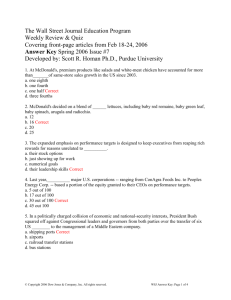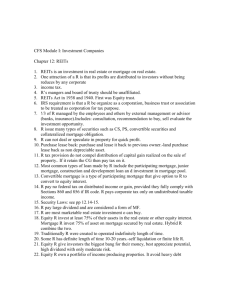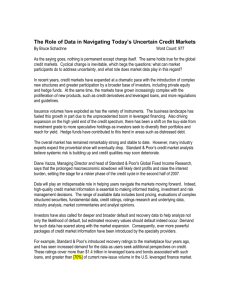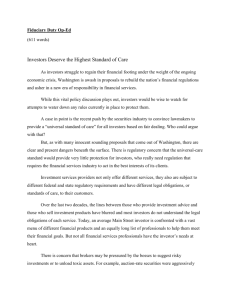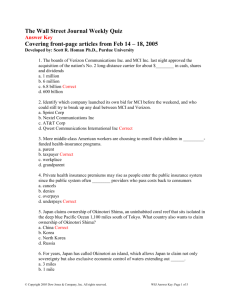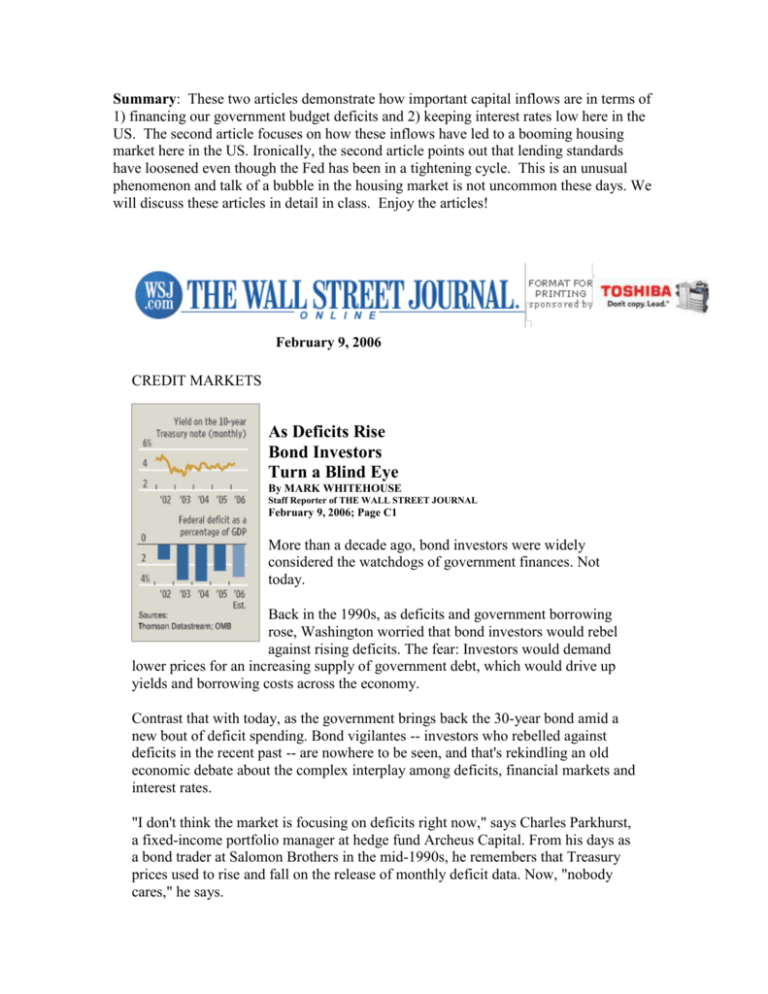
Summary: These two articles demonstrate how important capital inflows are in terms of
1) financing our government budget deficits and 2) keeping interest rates low here in the
US. The second article focuses on how these inflows have led to a booming housing
market here in the US. Ironically, the second article points out that lending standards
have loosened even though the Fed has been in a tightening cycle. This is an unusual
phenomenon and talk of a bubble in the housing market is not uncommon these days. We
will discuss these articles in detail in class. Enjoy the articles!
February 9, 2006
CREDIT MARKETS
As Deficits Rise
Bond Investors
Turn a Blind Eye
By MARK WHITEHOUSE
Staff Reporter of THE WALL STREET JOURNAL
February 9, 2006; Page C1
More than a decade ago, bond investors were widely
considered the watchdogs of government finances. Not
today.
Back in the 1990s, as deficits and government borrowing
rose, Washington worried that bond investors would rebel
against rising deficits. The fear: Investors would demand
lower prices for an increasing supply of government debt, which would drive up
yields and borrowing costs across the economy.
Contrast that with today, as the government brings back the 30-year bond amid a
new bout of deficit spending. Bond vigilantes -- investors who rebelled against
deficits in the recent past -- are nowhere to be seen, and that's rekindling an old
economic debate about the complex interplay among deficits, financial markets and
interest rates.
"I don't think the market is focusing on deficits right now," says Charles Parkhurst,
a fixed-income portfolio manager at hedge fund Archeus Capital. From his days as
a bond trader at Salomon Brothers in the mid-1990s, he remembers that Treasury
prices used to rise and fall on the release of monthly deficit data. Now, "nobody
cares," he says.
Bond-market professionals see the return of
the 30-year Treasury, which they call
simply "The Bond," as a boon, because it
revives a familiar benchmark and provides
pension-fund managers with the kind of
safe, long-term investment they need to
cover obligations to future retirees.
Traders expect strong demand at today's
auction of $14 billion in 30-year Treasurys
-- the government's first such auction in
five years. That would push prices on the
bonds higher, and thus yields lower.
Traders say the yield on the new issue
could come in as much as 0.1 percentage
point below that on the most comparable
issue, a 25-year government bond that
yields 4.68%.
"It's like welcoming back an old friend,"
says Gerald Lucas, head of Treasury and
agency strategy at Banc of America
Securities in New York.
Economists disagree about the impact that deficits have on interest rates. President
Bush said Monday that the budget deficit will reach $423 billion this year, or about
3.2% of gross domestic product, compared with a 40 year average of 2.3%.
Economic theory says that should matter. To finance the deficit, the Treasury
expects to issue a record $188 billion in new debt this quarter alone.
Theoretically, the more bonds the government issues to finance its deficits, the less
investors should be willing to pay for them, all else being equal. That, in turn,
should push up Treasury yields, punishing the government by increasing its cost of
borrowing. The higher interest rates would also hurt economic growth by making
corporate borrowing less attractive -- an effect that economists call "crowding out."
One recent study published by the Federal Reserve suggests the swing in budget
projections from surplus to deficit over the past five years should have pushed up
long-term interest rates by more than a full percentage point. Another study, done
in part by Glenn Hubbard, a former head of President Bush's Council of Economic
Advisors, finds a slightly smaller effect. Others see no effect at all.
Real-world experience challenges the theory. Japan saw long-term interest rates fall
amid persistent large budget deficits in the 1990s (though the Japanese people more
than made up for the government spending by saving a lot themselves). And even
though the U.S. budget has swung from a surplus of more than $200 billion in
2000, the yield on the 10-year U.S. Treasury note has fallen from more than 6%
then to about 4.5%.
"We've learned during the Bush administration that you can run big deficits and
there isn't any near-term pain," says Kevin Hassett, a former Federal Reserve
economist who now directs economic policy studies at the right-leaning American
Enterprise Institute. "So politicians can be irresponsible...and get away with it."
Economists and analysts offer various explanations for the twist. Most notably,
deficits don't happen in a vacuum. In both the U.S. and Japan, downward pressure
on inflation (and in Japan's case outright deflation) played a critical role in driving
down rates even as deficits mounted.
Today, some say a "global savings glut" has helped to keep U.S. rates low, as
foreigners put extra savings into U.S. bonds, pushing prices up and yields down.
Other factors are at play. For instance, some argue that total U.S. government debt
actually hasn't reached the danger zone yet: According to the International
Monetary Fund, it's about 46% of gross domestic product, compared with about
62% for Euro-area countries.
And there's the role of psychology. After the dramatic swing from deficits to
surpluses in the late 1990s, some bond investors might have stopped believing in
dire deficit projections. "Investors have the sense that the projections aren't worth
the paper they're printed on," says Bill Dudley, an economist at Goldman Sachs in
New York.
Yet some economists think investors should be paying more, not less, attention to
deficits now than they did back in the 1990s. That's because the government has
less time to correct the problem. Baby boomers will begin to retire en masse in less
than a decade, potentially causing spending on entitlements like social security and
Medicare to balloon. That, in turn, could drive government borrowing even higher.
"The situation is harder right now than it was in the early 90s," says Greg Mankiw,
an economics professor at Harvard University and, like Mr. Hubbard, a former head
of the Council of Economic Advisers. "Even if the bond market doesn't seem
concerned right now, the policy makers should be."
At 4 p.m., the benchmark 10-year Treasury note fell 5/32, or $1.56 for each $1,000
invested, to push up the yield to 4.595%. The 30-year bond fell 7/32, to yield
4.679%.
Corporate Bonds
Dow Jones & Co. Inc., publisher of the Wall Street Journal, had its long-term
credit rating cut yesterday by Standard & Poor's, which cited stiff competition for
advertising dollars and a reliance on volatile business-to-business advertising
revenues.
The downgrade to triple-B-plus affects about $470 million of debt. The outlook for
the rating is negative.
Cash flow at Dow Jones' print publishing business was weaker in 2005 than S&P
anticipated because of a modest decline in advertising revenue, S&P analyst
Michael Scerbo wrote in a report. He cited "ongoing competition in the media
space and a shift by some advertisers to more targeted advertising, particularly
online." Also reducing cash flow in 2005 were start-up costs associated with the
Weekend Edition of the Journal and higher newsprint costs.
S&P expects cash flow to improve in 2006, supported by the Weekend Edition.
"Dow Jones has a strong balance sheet supporting our strong, investment-grade
credit ratings, and the issuance of this downgrade has no impact on our borrowing
ability or our borrowing costs," said Chris Vieth, chief financial officer of Dow
Jones.
The downgrade bumps Dow Jones out of S&P's single-A rating category where
several of its peers are rated, including the New York Times Co., which has a
single-A rating from S&P, and the Washington Post Co., which is rated single-Aplus.
Dow Jones's credit profile has weakened in recent years in part because of several
acquisitions, including its purchase of MarketWatch for about $528 million.
But the new ratings provide some flexibility for further capital investments in
newspaper operations and modest-size acquisitions, S&P noted.
Rival rating service Moody's Investors Service placed Dow Jones' A2 rating under
review for a possible downgrade earlier this month.
In addition to The Wall Street Journal and its international and online editions, Dow
Jones publishes Dow Jones Newswires, Barron's and the Far Eastern Economic
Review, Dow Jones Indexes, MarketWatch, and the Ottaway group of community
newspapers. Dow Jones is co-owner with Reuters Group of Factiva and with
Hearst Corp., of SmartMoney. Dow Jones also provides news content to CNBC and
radio stations in the U.S.
---- Christine Richard contributed to this article.
Write to Mark Whitehouse at mark.whitehouse@wsj.com1
URL for this article:
http://online.wsj.com/article/SB113941361026668414.html
Hyperlinks in this Article:
(1) mailto:mark.whitehouse@wsj.com
Copyright 2006 Dow Jones & Company, Inc. All Rights Reserved
This copy is for your personal, non-commercial use only. Distribution and use of this
material are governed by our Subscriber Agreement and by copyright law. For nonpersonal use or to order multiple copies, please contact Dow Jones Reprints at 1-800-8430008 or visit www.djreprints.com.
was IndyMac. But the bulk of the money came from investors in Asia.”
August 24, 2005
PAGE ONE
Housing-Bubble Talk
Doesn't Scare Off Foreigners
Global Investors Gobble Up
Mortgage-Backed Securities,
Keeping Prices Strong
By RUTH SIMON, JAMES R. HAGERTY and JAMES T. AREDDY
Staff Reporters of THE WALL STREET JOURNAL
August 24, 2005; Page A1
Strong demand for mortgage-backed securities from investors world-wide is allowing
American lenders to make more loans -- and riskier ones -- in a way that is helping
prolong the boom in U.S. house prices.
The cash pouring in -- not only from U.S. investors but increasingly from Europe and
Asia -- keeps stoking the housing market even as the Federal Reserve Board continues
to raise interest rates, normally something that damps home prices. The market has
shown a few signs of slowing recently, and talk of a bubble has grown louder, but
prices continue to rise or remain at lofty levels as investors continue to gobble up
mortgage-backed securities and banks keep
lending.
HOUSING BOOM
1
Read more about the housing
market2 and see home-buying
calculators and resources.
"As the Fed has tightened, lenders have eased"
terms for borrowers, says Mark Zandi, chief
economist at Economy.com, a forecasting firm
in West Chester, Pa.
Investment banks and other firms have been
buying mortgage loans from lenders and
packaging them into securities for sale to
investors since the 1980s. But investor
demand has surged in recent years, largely because in an era of low returns, mortgagebacked securities offer yield-starved investors much higher returns than government
bonds.
U.S. lenders will make about $2.8 trillion in home-mortgage loans this year, according
to the Mortgage Bankers Association.
The MBA estimates that about 80% of
these loans will end up in mortgagebacked securities. Mortgage-backed
securities outstanding at the end of the
first quarter totaled $4.61 trillion, up 61%
since the end of 2000. In the same period,
total Treasury securities outstanding grew
35% to $4.54 trillion.
Investors' strong demand for mortgage
debt, besides allowing lenders to offer
many borrowers better terms, has also
made it easier to offer mortgages to
borrowers who might not easily qualify
for a loan. The growth of the mortgage
markets spreads the risks around. But
some mortgage-industry analysts say
lenders have become less stringent in
their loan terms because they can sell
almost any type of loan to those who
package mortgage securities for investors.
"Loose lending standards are probably the single biggest thing fueling the speculative
fever we have today" in housing, says Kenneth Rosen, an economist who is chairman
of the Fisher Center for Real Estate at the University of California at Berkeley.
In a world of low interest rates, the market for mortgage securities is simply too big
and profitable for many investors to ignore. Investors can earn about 5.5% on
mortgage securities whose payments are guaranteed by Fannie Mae or Freddie Mac,
government-sponsored companies. Those who can stomach greater risk can buy
subprime mortgage securities, which come with no guarantee but can yield as much as
15%, according to Bear Stearns. By contrast, 10-year U.S. Treasurys yield about 4.2%;
the equivalent government securities in Germany yield about 3.2% and in Japan 1.5%.
The buyers of mortgage-backed securities include U.S. pension funds, hedge funds and
insurance companies. But overseas investors are the fastest-growing source of demand.
The trade publication Inside MBS & ABS estimates that foreigners held $280 billion
of U.S. mortgage securities at the end of 2004, or 6% of the total outstanding. The
foreigners' holdings rose 26% last year and have continued to bound ahead so far this
year, Inside MBS & ABS says.
"There's this insatiable appetite for mortgage-backed securities world-wide," says
Andrew Sciandra, a senior vice president at IndyMac Bancorp, a California thrift,
who heads a team that creates those securities. In the past year, Mr. Sciandra has met
with investors from places like Germany, France and Abu Dhabi. Asian investors now
account for roughly 10% to 20% of mortgage securities sold by IndyMac.
For homeowners, the growing international demand for mortgages means it's
increasingly likely that the money they borrow to buy a home or refinance their
mortgage is coming ultimately from outside the U.S. When Claude Gaty, a chef and
co-owner of a bistro in Las Vegas, recently refinanced the mortgage on his fourbedroom Las Vegas home, the lender was IndyMac. But the bulk of the money came
from investors in Asia.
IndyMac pooled Mr. Gaty's loan with about 3,000 other mortgages that carry a fixed
rate for the first three, five or seven years. Mr. Gaty is paying both principal and
interest on his loan, but most of the loans in the pool are interest-only mortgages,
which allow borrowers to pay no principal in the early years. When the $650 million
offering of triple-A rated bonds backed by these mortgages came to market in June, it
drew more than a dozen investors from Europe, Asia and the U.S., according to
Deutsche Bank, which handled the deal. Such bonds typically yield 0.75 to 1.15
percentage point more than Treasurys, Deutsche Bank says.
The most recent entrant to the market is China. Its banks are rich with deposits from
Chinese companies that earn dollars exporting to the U.S. Dollars have also been
handed to some banks by the government in Beijing as part of its efforts to strengthen
their balance sheets.
Until a few years ago, Chinese investors restricted U.S. investment mostly to
Treasurys. Now, to boost their yields and because they consider the market safe,
bankers from a number of institutions say they are devoting more of their portfolios to
mortgage securities. Some bankers say their goal is to have 40% of their U.S. dollars
in asset-backed securities.
China's government also is testing U.S. mortgage investment. The country's Bank of
Communications, the only bank with a mandate to help manage China's $700 billion of
foreign-exchange reserves, has recently put a sliver of those reserves into mortgage-
backed issues, according to a banker there. The State Administration of Foreign
Exchange, the government agency in charge of the reserves, declined to comment.
Zhu Kai, who helps manage U.S. dollar investments at Bank of China, says in a rare
interview that his mortgage-backed portfolio has "plenty of room to grow." Mr. Zhu
expresses confidence in the U.S. dollar and the health of the U.S. home market.
Housing is so vital to the U.S. economy, Mr. Zhu and some of his counterparts at other
Chinese banks reason, that U.S. authorities will prevent a bust.
Even the recent decision by the Chinese government to raise the value of its currency
by about 2% isn't likely to lead Chinese banks to shift their plans. "The timing may be
a little bit surprising but we will not change our investment portfolio," Mr. Zhu says.
While Asian investors have largely focused on triple-A-rated bonds, other investors
are buying lower-rated debt. These bonds, which are created when bankers carve up
pools of mortgages, offer higher yields, but also bear the first risk of losses should
borrowers default. Investors who buy these bonds in effect set the standards for which
mortgages are made by deciding how much extra yield they need to compensate for
the added risks of lower-quality loans. They include real-estate investment trusts,
hedge funds and investors from Europe.
Strong investor interest has also made loans available to borrowers with poor credit
and many other people who might otherwise have trouble getting a mortgage.
Subprime loans included in mortgage securities totaled $401.5 billion last year, nearly
double the total for 2003, according to Standard & Poor's. Meanwhile, loans with less
than full documentation of the borrower's income and assets accounted for 70% of
mortgage securities rated by Standard & Poor's in this year's first half, double the level
recorded in 2000.
"There's no question that [lending] standards have loosened over the past couple of
years," says Arthur Frank, director of mortgage research at Nomura Securities
International in New York. If house prices fall, "you may well have some pretty
serious credit problems," hurting holders of the lower-rated mortgage securities.
Mr. Zhu, the Chinese fund manager, is sanguine, for now. The U.S. housing market is
"maybe losing a bit of steam," Mr. Zhu says. "I think the monetary authorities, they
don't want this housing market to burst. I don't think it is a bubble. But if things go on
like this for another five years, it's a different story."
Write to Ruth Simon at ruth.simon@wsj.com3, James R. Hagerty at
bob.hagerty@wsj.com4 and James T. Areddy at james.areddy@wsj.com5
URL for this article:
http://online.wsj.com/article/0,,SB112484869024321472,00.html
Hyperlinks in this Article:
(1) http://online.wsj.com/page/0,,2_1176,00.html
(2) http://online.wsj.com/page/0,,2_1176,00.html
(3) mailto:ruth.simon@wsj.com
(4) mailto:bob.hagerty@wsj.com
(5) mailto:james.areddy@wsj.com
Copyright 2005 Dow Jones & Company, Inc. All Rights Reserved
This copy is for your personal, non-commercial use only. Distribution and use of this
material are governed by our Subscriber Agreement and by copyright law. For nonpersonal use or to order multiple copies, please contact Dow Jones Reprints at 1-800843-0008 or visit www.djreprints.com.

